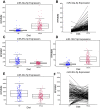Systems genetics identifies a co-regulated module of liver microRNAs associated with plasma LDL cholesterol in murine diet-induced dyslipidemia
- PMID: 28916633
- PMCID: PMC5792136
- DOI: 10.1152/physiolgenomics.00050.2017
Systems genetics identifies a co-regulated module of liver microRNAs associated with plasma LDL cholesterol in murine diet-induced dyslipidemia
Abstract
Chronically altered levels of circulating lipids, termed dyslipidemia, is a significant risk factor for a number of metabolic and cardiovascular morbidities. MicroRNAs (miRNAs) have emerged as important regulators of lipid balance, have been implicated in dyslipidemia, and have been proposed as candidate therapeutic targets in lipid-related disorders including atherosclerosis. A major limitation of most murine studies of miRNAs in lipid metabolic disorders is that they have been performed in just one (or very few) inbred strains, such as C57BL/6. Moreover, although individual miRNAs have been associated with lipid phenotypes, it is well understood that miRNAs likely work together in functional modules. To address these limitations, we implemented a systems genetics strategy using the Diversity Outbred (DO) mouse population. Specifically, we performed gene and miRNA expression profiling in the livers from ~300 genetically distinct DO mice after 18 wk on either a high-fat/high-cholesterol diet or a high-protein diet. Large-scale correlative analysis of these data with a wide range of cardio-metabolic end points revealed a co-regulated module of miRNAs significantly associated with circulating low-density lipoprotein cholesterol (LDL-C) levels. The hubs of this module were identified as miR-199a, miR-181b, miR-27a, miR-21_-_1, and miR-24. In sum, we demonstrate that a high-fat/high-cholesterol diet robustly rewires the miRNA regulatory network, and we identify a small group of co-regulated miRNAs that may exert coordinated effects to control circulating LDL-C.
Keywords: LDL-C; co-regulated modules; diversity outbred mice; dyslipidemia; microRNAs.
Figures







Similar articles
-
microRNAs in lipoprotein metabolism and cardiometabolic disorders.Atherosclerosis. 2016 Mar;246:352-60. doi: 10.1016/j.atherosclerosis.2016.01.025. Epub 2016 Jan 18. Atherosclerosis. 2016. PMID: 26828754 Free PMC article. Review.
-
Genome-wide identification of microRNAs regulating cholesterol and triglyceride homeostasis.Nat Med. 2015 Nov;21(11):1290-7. doi: 10.1038/nm.3980. Epub 2015 Oct 26. Nat Med. 2015. PMID: 26501192 Free PMC article.
-
Differential microRNA response to a high-cholesterol, high-fat diet in livers of low and high LDL-C baboons.BMC Genomics. 2012 Jul 18;13:320. doi: 10.1186/1471-2164-13-320. BMC Genomics. 2012. PMID: 22809019 Free PMC article.
-
MicroRNA 302a is a novel modulator of cholesterol homeostasis and atherosclerosis.Arterioscler Thromb Vasc Biol. 2015 Feb;35(2):323-31. doi: 10.1161/ATVBAHA.114.304878. Epub 2014 Dec 18. Arterioscler Thromb Vasc Biol. 2015. PMID: 25524771 Free PMC article.
-
MicroRNAs and lipid metabolism.Curr Opin Lipidol. 2017 Jun;28(3):273-280. doi: 10.1097/MOL.0000000000000420. Curr Opin Lipidol. 2017. PMID: 28333713 Free PMC article. Review.
Cited by
-
MyoData: An expression knowledgebase at single cell/nucleus level for the discovery of coding-noncoding RNA functional interactions in skeletal muscle.Comput Struct Biotechnol J. 2021 Jul 26;19:4142-4155. doi: 10.1016/j.csbj.2021.07.020. eCollection 2021. Comput Struct Biotechnol J. 2021. PMID: 34527188 Free PMC article.
-
High-fat diet negatively impacts both metabolic and behavioral health in outbred heterogeneous stock rats.Physiol Genomics. 2020 Sep 1;52(9):379-390. doi: 10.1152/physiolgenomics.00018.2020. Epub 2020 Jul 20. Physiol Genomics. 2020. PMID: 32687430 Free PMC article.
-
The potential of integrating human and mouse discovery platforms to advance our understanding of cardiometabolic diseases.Elife. 2023 Mar 31;12:e86139. doi: 10.7554/eLife.86139. Elife. 2023. PMID: 37000167 Free PMC article.
-
microRNA-146a-5p association with the cardiometabolic disease risk factor TMAO.Physiol Genomics. 2019 Feb 1;51(2):59-71. doi: 10.1152/physiolgenomics.00079.2018. Epub 2019 Jan 11. Physiol Genomics. 2019. PMID: 30633643 Free PMC article.
-
Association between MEG3/miR-181b polymorphisms and risk of ischemic stroke.Lipids Health Dis. 2018 Dec 22;17(1):292. doi: 10.1186/s12944-018-0941-z. Lipids Health Dis. 2018. PMID: 30579356 Free PMC article.
References
-
- Baran-Gale J, Kurtz CL, Erdos MR, Sison C, Young A, Fannin EE, Chines PS, Sethupathy P. Addressing bias in small RNA library preparation for sequencing: a new protocol recovers microRNAs that evade capture by current methods. Front Genet 6: 352, 2015. doi:10.3389/fgene.2015.00352. - DOI - PMC - PubMed
-
- Calo N, Ramadori P, Sobolewski C, Romero Y, Maeder C, Fournier M, Rantakari P, Zhang FP, Poutanen M, Dufour JF, Humar B, Nef S, Foti M. Stress-activated miR-21/miR-21* in hepatocytes promotes lipid and glucose metabolic disorders associated with high-fat diet consumption. Gut 65: 1871–1881, 2016. doi:10.1136/gutjnl-2015-310822. - DOI - PubMed
MeSH terms
Substances
Grants and funding
LinkOut - more resources
Full Text Sources
Other Literature Sources
Medical
Molecular Biology Databases

